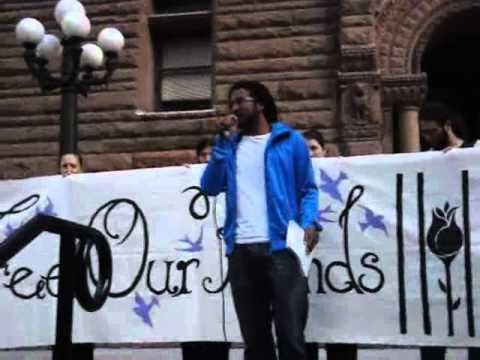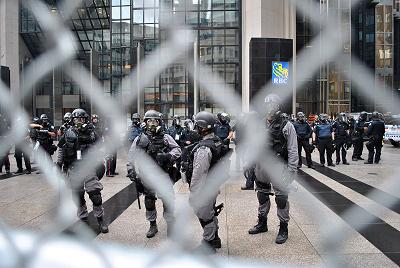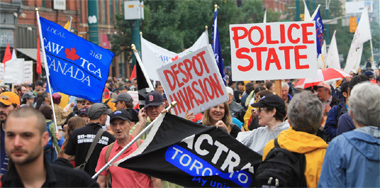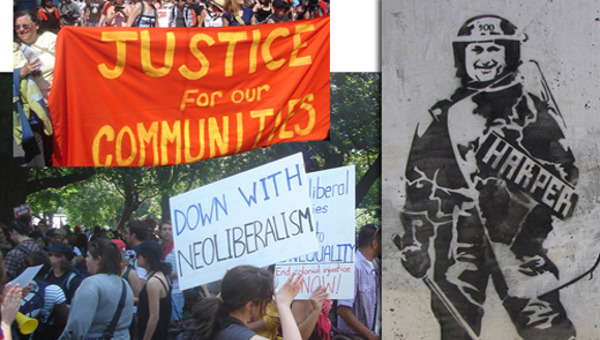In the Aftermath of the G20: Reflections on Strategy, Tactics and Militancy
The events at the Saturday G20 demonstration in Toronto last week have provoked a series of responses already. This article is not meant to review the events of the day itself, but to look at the questions raised by the demonstrations and tactics used for the left.
Suffice to say the reaction of the police, in arresting, detaining, and brutalizing nearly 1,000 people in the largest mass arrest in Canadian history, exposes the serious attacks on civil liberties the left faces.
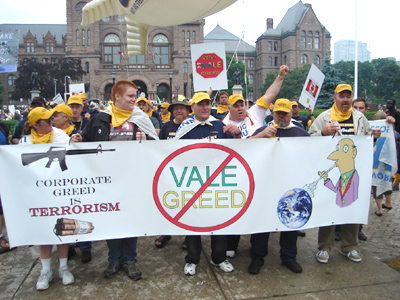
On the Friday before the demonstration I was having a beer with a comrade in Halifax and, of course, discussion turned to the G20. We both agreed that this would be the perfect demonstration to go off without any property damage. If at the end of the day tens of thousands marched, thousands did sit-ins by the fence, but the tactic of smashing windows was not employed, then the Summit would be a defeat for [Prime Minister] Stephen Harper’s Conservative government.
We drew this analysis based on the fact that everywhere you went there was anger at the billion dollar price tag for security. At a time when thousands are struggling to make ends meet and see the cost of the Summits as exorbitant. Many, consciously or not, recognize that this money is being spent on the architects of the crisis, protecting those who gave billions to the banks while leaving workers and the poor to pay for it. Furthermore, in the lead-up to the Summit, there was a growing polarization of opinion in Canada with many being angry or frustrated with Harper’s attacks on civil liberties, on women’s rights, on the climate, on the economy, and more.
A Protest Pattern
To have had a day of mass demonstrations and militant but non-violent action would have left Harper with egg on his face, and given more confidence to those who want to find ways to challenge Harper and the capitalist market. Instead, the day followed, in many ways, a clock work pattern – much like other summits. First, there’s a mass demonstration. Then a layer of people do a split from that march and, sooner or later, some engage in expressing their rage against the system by smashing windows and other acts. Given the world we live in, it is surprising that more of this doesn’t happen more often.
In response, the police hold back until the main march disperses. They wait for some damage to be done, and then they go on the offensive. They round-up and brutalize everyone left on the streets, including passers-by, peaceful protesters and those engaged in property damage. In Seattle, Québec, Genoa, and others, this script has played out over and over again. The police wait until the mass organizations leave, then go after the rest. This strategy suggests that the police and the state are keenly aware of who they want – and don’t want – to provoke.
Within this context, the “Black Bloc” and their supporters utilize the larger rally and split marches to launch attacks on property and the police. Usually the police wait long enough for damage to be created before they respond. It is one of the few times the police wait to crack down.
Then, when the cops attack, the Bloc usually retreats and tries to merge with others. In Genoa, the Black Bloc ran through a group of nuns engaged in a sit-in which resulted in the police attacking the nuns. In New York City, at a demonstration against WEF (World Economic Forum), the Black Bloc ended up running from the police and trampling down women Steelworkers from Toronto, who were then attacked by the police as the Bloc hid behind the Steelworkers.
Then the media and police trot out the usual line ‘We are ok with protests, but a small minority of criminals can’t be tolerated.’ Those innocents that were arrested were an unfortunate by-product of protecting the city and its inhabitants. The police and politicians then justify the violence against protestors as necessary to stop any further violence.
In the process, hundreds get arrested while the media spends the next several days reducing the estimated numbers of demonstrators, erasing on-site reports of police brutality, critiquing the police as being too passive. Then the police say they weren’t able to protect property at the start because they were committed to facilitating the peaceful protest. Afterward they ‘did everything possible to restore order.’ Throughout all this, stories begin to emerge about undercover officers mingling with crowd, engaging in and trying to stir up ‘action.’ Eventually a handful gets charged with some serious offences and the majority arrested get released with few or no charges.
What Are the Lessons?
Despite the media hype there was nothing new about the events in Toronto. The question for militants is: what are the lessons? How do we interpret events and what do they mean for the left? To answer, we need to look at what the mobilizations can achieve and why they are important. This is the critical starting point. Since the rise of the anti-globalization movement, this has been a point of debate.
The mobilizations around Summits are important, first, because they provide an opportunity to mobilize people beyond the ranks of those already active. It is more possible because the media builds the events far beyond the reach of the left. The fact that the summits raise a broad set of issues, mean that they unite in opposition broad sets of movements. The demonstrations that result can often be greater than the sum of the parts of movements. They unite various movements – labour and environment for example. They provide an opportunity to bring wider layers into the movement.
Some have argued that these demonstrations are pointless one-off events and that those who go to them are “summit-hoppers.” Strangely these critiques are often raised by people who themselves go to the events. But this misses the point that while the mobilizations are one-offs they are important in the sense that they pull struggles together and allow those not plugged into activism to find a space to join the movement.
Secondly the protests show to millions of others that there is mass opposition to the system. The idea that the protests themselves will stop the overall agenda of the rulers is mistaken, while the protests can hinder the implementation of certain policies, they cannot by themselves stop capitalism in its tracks. But the more important point of the protests is their ability to galvanize and mobilize opposition to the system. For the left and the movements, the demonstrations offer a crucial opportunity to grow and sink deeper roots in new areas. These mobilizations also help maintain momentum and break down barriers between struggles that often go on in their own silos. In short, these protests forge new bonds of solidarity.
So it is important to mobilize against these Summits, not because we can directly change the agenda, or that capitalism will grind to a halt if the Summit is shut down. Some thought because of the collapse of the World Trade Organization talks in Seattle, or the inability to get a deal at the Free Trade Areas of the Americas meeting at Québec City, that capitalism would be forced into a retreat. But the reality is that these Summits are attempts to overcome divisions between various ruling classes in various nation states. What they can’t get through global agreements, they will try through regional agreements. What isn’t accomplished regionally is taken up bi-laterally. Basically, Summits are where the world’s largest economies jockey with each other for a better deal for their own ruling classes.
This doesn’t mean we can’t wrestle reforms from these leaders, and without the demonstrations it would be even harder to win reforms or prevent even more damaging policies from being implemented. Even NGOs who aren’t committed to the revolutionary overthrow of capitalism understand that mobilizing is vital to back their call for reforms.
In this context, the object of mobilizing for the Summits should be to try and take advantage of the moment presented to broaden and deepen the left and build the movements.
This is the objective from which our tactics flow. It is not the Summit itself that matters but the ability to draw larger numbers onto the streets and into action. It offers the potential to increase people’s confidence and consciousness.
Strategy Versus Tactics
To establish tactics before determining the larger strategic objectives, raises tactics to a point of principle and robs the working class of the tactical flexibility that will maximize success. Tactics are the tools we implement to bring about a result. Common sense tells us that a desired outcome be discussed first, then the strategy to get there, and, finally, what tactics would best deliver the outcome. To start with tactics is wrongheaded and creates the quixotic adventures we saw on June 26 in Toronto.
So what about “diversity of tactics” and the Black Bloc?
It should be clear that the actions of the Black Bloc reflect their politics. The actions in Toronto mirror the tactics used elsewhere. The tactics and politics regardless of their intent are inherently elitist and counter-productive. In fact they mirror the critique of reformism many on the left have. The NDP says ‘vote for us and we’ll do it for you’; the Black Bloc says in essence the same thing – ‘we will make the revolution for you.’
At best the tactics of the Black Bloc are based on a mistaken idea that the attacks on property and the police will create a spark to encourage others to resist capitalism, at worst they are based on a rampant individualistic sense of rage and entitlement to express that rage regardless of the consequences to others. The anti-authoritarian politic they follow is imposed on others. Very rarely will you see a Black Bloc call its own rally. Instead the tactic is to play hide and seek with the police under the cover of larger mobilizations.
Further, as has been noted in many cases, the tactics and politics of the Black Bloc – and some anarchists and some others on the left – leave them prone to being manipulated by the state. In almost every Summit protest, police and others (in Genoa it was also fascists), infiltrate or form their own blocs to engage in provocations. The politics of secrecy and unannounced plans and a quasi-military (amateur at best) approach to demonstrations leave the door open to this.
The tactics also open the door for the justification of further police repression. This has been debated before, with some arguing that the state doesn’t need justification for repression. The idea that the state doesn’t need justification for further repression exposes the total lack of understanding of both the state and the consciousness of ordinary people.
If the state didn’t need justification for repression, then we would all be in jail. Capitalism isn’t a democratic system, but needs the facade of liberal political rights to maintain legitimacy about how free and equal we all are. If the state didn’t need justification for repression, then we accept that people are just automatons who do what they are told.
But the reality is that most people oppose police brutality and most people believe we are living in a democracy. Therefore, when the police go on a rampage, they have to have an excuse. It is highly naive to think that the police and the state won’t and don’t need a justification to repress people. If they didn’t we wouldn’t have a war on drugs – it would have just been called what it most often has been – a war on the poor.
What is Radical?
Some argue that we have to support some of these tactics because they are “radical.” But what, indeed, is so “radical”? Let us put aside the notion of “economic disruption” caused by a few burning cop cars and broken windows, as some use this to justify so called militant actions. Let us take another example. The reality is the Tamil community created much more economic disruption with their non-violent occupation of the Gardiner Expressway in Toronto, and their sit-ins shutting University Avenue. Further, the workers in Sudbury valiantly fighting Vale Inco are doing much more to disrupt the economy than a thousand Black Bloc actions ever could.
The tactics of the Black Bloc make it clear that, for them, it is more important to smash windows than to try and march with thousands of workers and engage them in arguments about how to move struggles forward or that the problem is capitalism.
So how radical is it to trash a few windows? It depends on what one means by radical.
For us, radical is about workers gaining confidence and consciousness to fight back, not just at work, but in solidarity with others. Radical is about developing a sense of mass power, organising based on moving others into struggle, winning others to challenge the power in their workplace or community collectively, beyond the individualization of our society. Radical is about going to the roots of the system – not trashing its symbols.
So it is much more radical organising a Starbucks, or winning co-workers to fight homophobia, or defending women’s rights, than it is smashing a window.
When the Black Bloc does its thing, does it move struggles forward or backward? Does it in the eyes of those questioning the system, or moving into struggle, or thinking that something is wrong, radicalize them and give them confidence?
The answer is that outside of a small minority, these actions at best can inspire passive support from those who do not like police. But the majority have no confidence to engage in these actions themselves or agree with them. Instead of giving confidence, the tactics generally produce confusion and play into the hands of the state that would prefer it if no one ever protested. They allow the state to justify its repression and expenditures. In essence outside of an already radicalized minority they don’t leave anyone with a deeper sense of confidence about the ability to fight capitalism. Instead at best they leave the impression that the fight against capitalism can only be carried out by a heroic minority, at worst they leave people worrying about going to demonstrations. The tactic is far from radical because it does nothing to challenge capitalism in any way; it does nothing to instil confidence in others to resist.
The debate shouldn’t be about violence, per se, but about tactics and strategy. Of course we defend the right of workers and oppressed communities to self-defence. The response from the left to the riots in Toronto after the Rodney King beating by police in Los Angeles is a good example: many defended the justified outrage at both the racism of the justice system and the beating of King. It was a justifiable rage against a system of racism. But it wasn’t a strategy to defeat racism.
The Black Bloc, however, isn’t even an oppressed community resisting oppression and defending itself. Those on the left who see the problems with the Black Bloc, and the cover given to them by those who elevate “diversity of tactics” to a principle, need to organize coherent responses to this.
Debating Strategy and Moving Forward
We need to join the battle for interpretation without getting distracted by blanket pronouncements of “pro” this or “anti” that. We need to focus on strategy and the tactics that flow from it. This will allow us to regroup those activists who see the centrality of the working class as the key to social change, who recognize that intended or not, “diversity of tactics” is not radical but a cover for self-aggrandisement by some tiny groups who have no faith in the self-activity of the working class.
The need for a bigger stronger socialist movement in Toronto couldn’t be greater than it is now. The role of socialists isn’t to tail gingerly those who support “diversity of tactics,” but to politically debate and expose the bankruptcy of those ideas for moving struggles forward. And it goes without saying that while we do that, we must also be defending those arrested, exposing the brutality of the police and patiently explaining to co-workers and neighbours what really happened and why people protested.
We need this clarity to avoid the sort of splits in the movements that occurred after Québec City and after 9/11. We need this clarity and upfront politics to win those pulled by the anger at the system and its barbarism to a more effective – if less sexy – strategy, based on building a mass struggle against capitalism that can pull the system up by its roots. •
This essay is part of a series of articles to be published in the upcoming issue of Socialist Worker which can be found at www.socialist.ca and issuu.com/socialistworker/docs.


